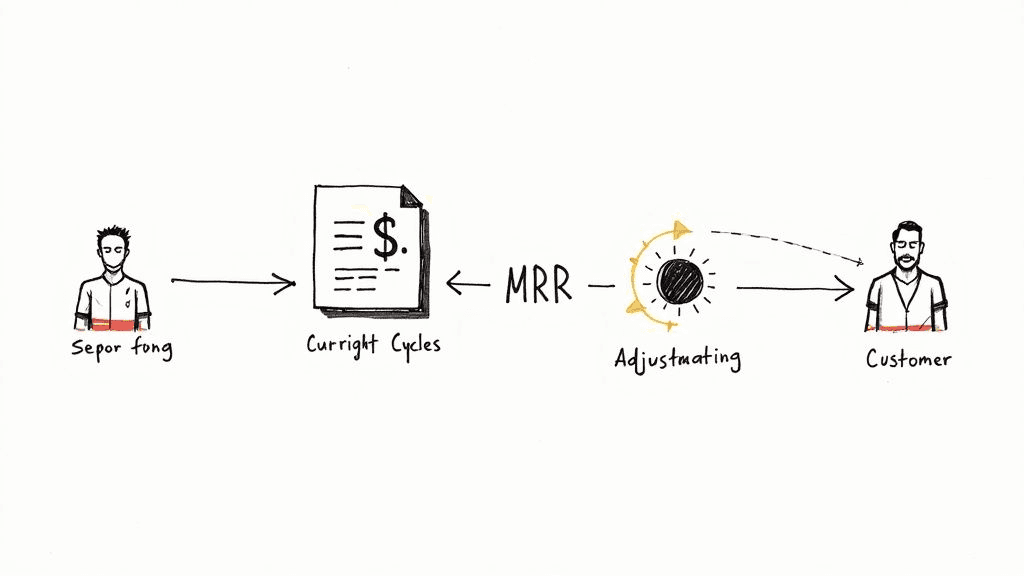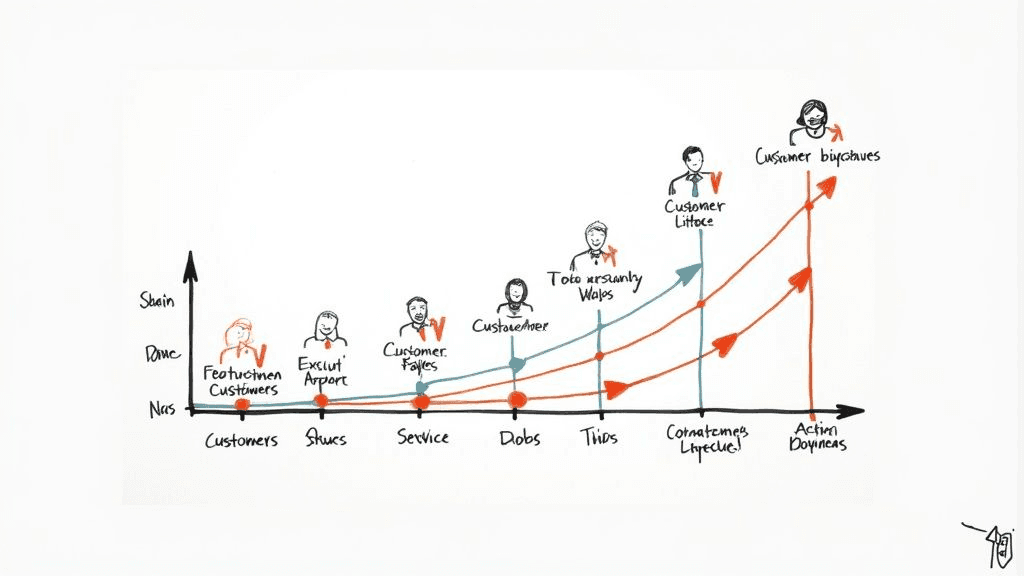How to Calculate MRR: Your Ultimate Guide to Monthly Recurring Revenue
Master the art of calculating Monthly Recurring Revenue (MRR) with proven strategies that drive tangible results. Learn from industry experts and discover practical approaches to tracking, analyzing, and optimizing your recurring revenue.
Understanding the True Power of MRR

Monthly Recurring Revenue (MRR) forms the foundation of subscription business success. Unlike one-time sales that can vary dramatically month to month, MRR provides a steady, predictable view of your company's income. This consistency enables better planning, forecasting, and business decision-making.
Why MRR Matters More Than Traditional Revenue Metrics
Standard revenue tracking falls short for subscription companies since it misses the ongoing nature of revenue streams. For instance, while a big one-time sale might boost monthly numbers, it doesn't show sustainable growth. MRR, on the other hand, focuses purely on predictable, recurring income. This gives a much clearer picture of long-term business health and helps spot trends early. Not surprisingly, investors value strong MRR since it signals stability and growth potential.
How MRR Reveals Your Company's True Health
Think of MRR as your company's vital signs monitor. When it steadily increases, it shows healthy growth and good customer retention. If it starts declining, it may point to issues with customer churn, pricing, or product-market fit. By watching MRR closely, you can spot and fix problems quickly before they become serious.
The basic MRR calculation multiplies the Average Revenue Per User (ARPU) by total users. For example, if you have 50 subscribers each paying $100 monthly, your MRR would be $5,000 (50 x $100). Learn more about MRR calculations here: Understanding Monthly Recurring Revenue
Key MRR Indicators for Future Growth
Breaking down MRR into its components provides detailed insights into growth drivers:
New MRR shows how well you're acquiring customers
Expansion MRR from upsells reflects customer engagement
Contraction MRR from downgrades may signal pricing issues
Churned MRR points to retention challenges
This detailed view helps identify exactly what's working and what needs improvement. For subscription businesses aiming for steady growth, understanding and acting on these MRR metrics is essential for building lasting success.
Mastering Essential MRR Calculation Methods

Getting an accurate picture of Monthly Recurring Revenue (MRR) requires more than basic math. Modern SaaS businesses need to account for different pricing tiers, contract lengths, and usage patterns to get reliable MRR numbers. Let's examine the key methods and best practices for precise MRR calculations.
Handling Complex Pricing Models
When you offer multiple pricing tiers, calculating MRR requires breaking down your subscriber base by plan level. For each tier, multiply the number of active subscribers by their monthly fee, then add up the totals across all tiers.
For instance, if you have 100 subscribers on a Basic plan at $50/month and 50 subscribers on Premium at $150/month, your total MRR would be (100 x $50) + (50 x $150) = $12,500. This segmented approach gives you clear visibility into revenue from each tier.
Navigating Variable Subscription Terms and Billing Cycles
Annual contracts need special treatment in MRR calculations. To get an accurate monthly view, take the total annual contract value and divide it by 12. This lets you compare annual and monthly plans on equal terms.
Contract start dates also matter. Take a $120,000 annual contract starting May 15, 2020, and ending May 14, 2021. You'd record $10,000 in MRR ($120,000 ÷ 12) starting in May 2020. If the contract doesn't renew, that same amount drops off in May 2021. See more details on this topic at Maxio's guide to calculating MRR.
Addressing Mid-Month Changes
When subscribers upgrade, downgrade or cancel mid-month, consistent timing is key. Many companies choose to measure MRR based on active subscriptions at month-end. This provides a clear snapshot for tracking trends and comparing performance between periods.
Maintaining Accuracy at Scale
Manual MRR calculations become impractical as your customer base grows. Using dedicated billing software or CRM integrations helps automate the process and reduce errors. Clear internal guidelines and staff training further ensure your MRR reporting stays accurate and reliable over time.
This focused approach to MRR calculation, supported by the right tools and processes, gives you the solid data you need to understand your business performance and make sound decisions.
Breaking Down MRR Components for Growth Insights

Looking closely at each type of Monthly Recurring Revenue (MRR) gives you clear insights into how your business is performing. Rather than just calculating total MRR, analyzing its key components helps identify specific areas for improvement and growth. Let's examine the essential building blocks that make up your overall MRR.
New MRR: Measuring Acquisition Success
New MRR shows how much revenue comes from first-time customers each month. This metric directly reflects whether your marketing and sales efforts are working. When you see strong New MRR numbers, it means you're successfully bringing in customers and your go-to-market approach is effective. Following this metric helps you gauge your ability to attract new business.
Expansion MRR: Identifying Growth Opportunities
Expansion MRR comes from existing customers who increase their spending through upgrades or additional services. This growth signals that customers find real value in your product and want to invest more. Rising Expansion MRR points to happy customers and strong long-term potential. It also shows that your customer success team is doing well at helping clients get more from your product.
Contraction MRR: Addressing Downgrades and Discounts
Contraction MRR represents money lost when existing customers downgrade or receive discounts. This metric often hints at issues with pricing, product satisfaction, or market competition. Watching Contraction MRR closely lets you spot and fix problems before they grow. You may need to adjust prices, improve features, or boost your support to address the root causes.
Churned MRR: Understanding Customer Retention
Churned MRR tracks revenue lost from customers who cancel completely. This key metric reveals how well you retain customers over time. High Churned MRR often means customers aren't satisfied, your product isn't meeting market needs, or competitors are winning them over. Analyzing why customers leave helps you make changes to keep them longer. For more insights, check out: How to Master the Impact of Customer Success on Gross and Net Retention.
The Power of Combined MRR Insights
Looking at all MRR components together shows the full picture of your business health. For instance, strong New MRR plus low Churned MRR suggests healthy growth and satisfied customers. But flat New MRR and rising Contraction MRR may mean you need to revisit pricing or product features. These insights guide smart decisions about where to focus your efforts for steady, sustainable growth. Tracking each component, along with total MRR, is key to building a successful SaaS business.
Choosing and Implementing the Right MRR Tools

Tracking Monthly Recurring Revenue (MRR) accurately is essential for any subscription business. The tools you choose to monitor and analyze MRR can make a real difference in understanding your revenue trends and making smart growth decisions.
Matching Tools to Business Stage
Starting out, basic spreadsheets work fine for tracking MRR in small companies. But as your customer base grows and pricing gets more complex, you'll need something more robust. Dedicated subscription management platforms can automatically calculate key metrics like new MRR, expansion revenue, and churn – giving you reliable data without the manual work.
For instance, if you have one product and 20 customers, Excel might do the job. But managing thousands of subscribers across multiple pricing tiers requires purpose-built software to handle the complexity and provide accurate reporting.
Essential Features to Consider
When looking at MRR tools, focus on these key capabilities:
Automated Calculations: Takes the manual work out of tracking revenue
Billing System Integration: Syncs your revenue data automatically
Flexible Reporting: Lets you track metrics that matter to your business
Growth Forecasting: Projects future revenue based on current trends
The right tool should also include cohort analysis and connect with your CRM and other key business systems. See our article on Building a Stellar Marketing Career in B2B SaaS for more insights.
Evaluating Integration Capabilities
Your MRR tool must work smoothly with your billing system. Good integration means subscription data flows automatically, eliminating manual data entry and reducing errors. This also lets you analyze MRR alongside other business metrics for better decision-making.
Implementation Pitfalls to Avoid
Moving to a new MRR system can be tricky. Common issues include poor staff training, not validating data properly during the switch, and unclear processes for using the new tool. Success requires investing time in training, thorough testing, and creating clear guidelines for everyone using the system.
Learning from Successful Transitions
Companies that handle MRR tool transitions well follow a careful plan. They map out how data will move between systems, set clear timelines, and test extensively to ensure accuracy. Some run old and new systems together temporarily to verify everything works correctly. This methodical approach helps maintain data quality through the change. Having reliable MRR tracking is key for steering your SaaS business in the right direction.
Avoiding Critical MRR Calculation Mistakes
Understanding your SaaS company's true financial health requires accurate Monthly Recurring Revenue (MRR) calculations. Many businesses, even those with experienced teams, make mistakes that distort their MRR numbers and lead to problematic business decisions. Here's how to get it right.
Common MRR Calculation Errors
Several key mistakes can throw off your MRR calculations significantly:
Annual Contract Errors: Many teams forget to divide yearly contract values by 12 to find monthly revenue. This creates artificially high MRR in month one followed by a steep drop when the contract ends.
Mid-Month Changes: When upgrades, downgrades or cancellations happen mid-month, tracking gets messy. Pick a consistent point (like month-end) to measure MRR across your business.
Currency Confusion: For global businesses, using different exchange rates creates inconsistency. Choose one standard method for currency conversion and apply it consistently.
One-Time Fee Mix-ups: Setup charges and other non-recurring fees don't belong in MRR calculations. Keep your focus only on subscription revenue that recurs monthly.
Missing Discounts: Failing to subtract discounts and coupons makes MRR look higher than reality. Always factor these reductions into your recurring revenue totals.
Building a Foolproof System for Accurate MRR Tracking
Create reliable MRR tracking with these key elements:
Use Automation Tools: Manual calculations become error-prone as customer numbers grow. Billing software and CRM tools help eliminate mistakes while saving time.
Add Data Checks: Put verification steps in place before numbers enter your MRR calculations. Compare against other data sources and use automated rules to catch issues.
Keep Data Clean: Set aside time to review and update customer and subscription records. Remove duplicates, fix outdated information, and resolve data conflicts.
You might be interested in: How to Master Building a Successful Churn Prediction Model: Your Guide to Customer Retention
Recognizing Warning Signs of Potential MRR Calculation Issues
Watch for these red flags that suggest MRR calculation problems:
Sudden Changes: If MRR shifts dramatically without clear reason, investigate immediately to find the cause.
Metric Misalignment: Your MRR trends should generally match other key metrics like customer growth and churn. When they don't, something may be wrong.
Revenue Reality Gaps: Big differences between projected and actual revenue often point to calculation or forecasting errors.
Best Practices for Handling Edge Cases
Some pricing models need special attention:
Usage-Based Revenue: Create clear rules for converting usage into monthly recurring amounts. Consider using pricing tiers or historical usage patterns.
Tiered Pricing: Track revenue carefully across different pricing levels. Add up the recurring revenue from each tier for your total MRR.
Getting MRR calculations right takes careful attention to detail and good processes. When you have accurate MRR data, you can make smarter decisions about growing your business. Focus on preventing common mistakes and your MRR numbers will provide the reliable guidance you need.
Making the Most of MRR Analytics for Growth
Understanding Monthly Recurring Revenue (MRR) requires going deeper than basic calculations. Smart companies use analytics to spot growth opportunities, predict performance trends, and make better decisions based on data. Let's explore how to turn MRR data into real business insights.
Using MRR Trends to Plan Ahead
Rather than just tracking current MRR numbers, successful companies study how their MRR changes over time. Looking at historical patterns helps predict future growth and spot potential issues early. For example, steady increases in New MRR often mean your customer acquisition is working well, while dropping Expansion MRR may signal it's time to improve how you engage with existing customers.
Finding Growth Opportunities in MRR Data
A detailed analysis of your MRR components can reveal promising areas for growth. If your Expansion MRR is lower than desired, you might focus on upselling to current customers. Looking at segments with high Average Revenue Per User (ARPU) shows which types of customers tend to expand their subscriptions over time. This helps you concentrate your efforts where they'll have the greatest effect.
Making Decisions Based on MRR Insights
Clear reports and visual data help teams understand and act on MRR trends. A well-designed dashboard lets stakeholders quickly grasp your growth story. When everyone can easily see patterns in New MRR, Churned MRR, and overall growth, they can make more informed choices about products, marketing, and sales strategies.
Creating Forecasts with MRR Data
Modern analytics lets you move beyond tracking past performance to predicting future trends. By connecting MRR data with other key numbers like churn rate and customer lifetime value, you can build reliable forecasts. For instance, if you spot signs of future MRR decline, you can take early steps to reduce customer churn or improve your offerings.
Turning MRR Insights into Action
Every MRR insight should lead to specific business actions. Create clear connections between what your data shows and what steps to take next. If you see New MRR dropping, you might increase marketing spending or adjust your target market. When Churned MRR rises, focus on improving customer onboarding and support. By tracking how these changes affect your MRR, you can keep refining your approach for better results.
Want to learn more about scaling your SaaS business and leveraging key metrics like MRR? Check out SaaS Sessions, India's leading SaaS podcast, for expert insights and real-world examples from industry leaders.
